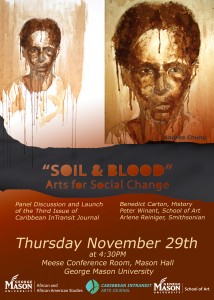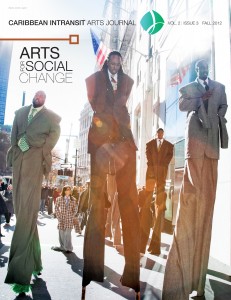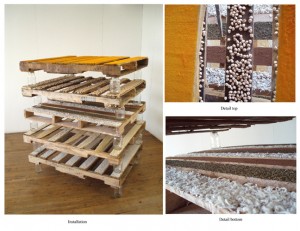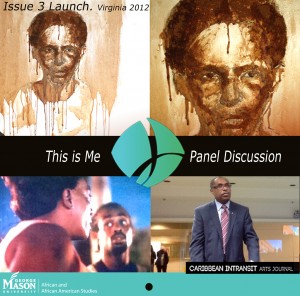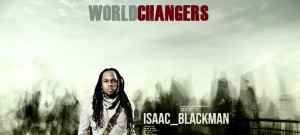Caribbean InTransit recently launched its third issue on “Arts for Social Change”. The launch entitled “Soil and Blood: Arts for Social Change” was staged in partnership with African and African American Studies (AAAS), George Mason University (GMU), the department under which Caribbean InTransit now falls and the School of Art, GMU. Dr. Wendi Manuel-Scott, Director of AAAS introduced the program, which also celebrated World Aids Day. The launch of Issue 3 of Caribbean InTransit was followed by a panel discussion. Discussants included Arlene Reiniger and Dr. Sojin Kim from the Smithsonian Center for Folklife and Cultural Heritage who spoke about the 2011 Folklife Festival, which focused on HIV/Aids and was entitled “Creativity and Crisis”, Peter Winant lecturer in the School of Art whose presentation was titled “Subversion in the Arts”, GMU and Benedict Carton of the Department of History, GMU whose topic was “HIV/Aids and Memory”
Caribbean InTransit is an open access academic journal focused on Caribbean arts and culture. The publication has a rigorous blind peer review process and welcomes submissions of manuscripts, visual arts and poetry in English, French and Spanish. The journal is published twice a year, in Spring and Fall. The concept of Caribbean InTransit is to provide a creative “meeting place” for Caribbean artists to share their thought-provoking ideas and works within a community of cultural producers, students, scholars, activists and entrepreneurs. The word “InTransit” signifies the historical and contemporary global movement of Caribbean peoples and the opportunities for becoming that this movement offers.
The vision of Caribbean InTransit is to foster a community of research and entrepreneurship related to artistic endeavors emerging from Caribbean cultural expressions of identity. Caribbean InTransit’s mission is to cultivate a spirit and community of artistry, entrepreneurship and networking between artists, audiences and organisations and to identify these areas as modes of transition and connection for the global Caribbean through a unique journal format, toward change in educational systems, research institutions and socio-cultural policies.
The theme of this third issue of Caribbean InTransit addresses a topic that is the functional premise of the enterprise: Arts for Social Change. Issue 3 is guest edited by Dr. Toby Jenkins, faculty at George Mason University Virginia and editor of Family, Community and Higher Education (2012) in the Routledge Research in Education series. Inclusive of essays, interviews, reviews, visual essays, poetry and creative fiction in French and English, this issue of Caribbean InTransit reflects on the importance of re-uniting the arts with the social domain.
Societies have continually compartmentalized knowledge in an effort to maintain hierarchical social orders. From information security regimes with levels of clearance to the Ford assembly line, where specialized knowledge of one aspect of the big picture was developed, to the disciplined knowledge of university students, compartmentalized knowledge acts as a buffer to critical apprehension of a larger reality. The Arts function as a bridge in re-connecting knowledges but also help to re-shape our modes of conceptualization. Andrea Chung’s piece entitled invisible cargo is an example of such a re-formulation. As a visual recipe for a traditional Jamaican curry dish, this fragile, provocative and imaginative work pushes to re-configure the relationship between our visual imagination of food and our languaging of its historical reality in our lives. In a similar vein architect Heather Pinnock re-organizes our architecture of seeing and understanding space versus place in her poem “Pathetic Fallacy”. Her voicing of the cookie-cutter government living units are registered as merely space that quell passion and stymie a sense of self. The voice of Leah who lives in these units, calls for some imagination in design to re-invigorate memory and life. Design, art is not separate from the very basic spaces that inform our experiences, the processes of our lives.
In her introduction to the issue, Jenkins discusses the ways in which the articles and artwork in the issue provide a platform for thinking about social transformation. Beginning with Jamaican artist Edna Manley, she articulates the criticality of planned exposure to art, which is an “indispensable element in the process of transformation” (Manley qtd. in Jenkins 2012). In support of such a position, Muarizio Caserta conveys the need to ‘speak’ the language of an art in order to consume it. If the artistic product does not match a need in society then consumption is impossible (Caserta 165). This supply-demand relationship between artistic product and community need is brought to life especially in Rodell Warner’s work ‘Common Room’ which highlights the dynamics of “public-to-public communication”(Warner) on city streets. The work, which was conducted in Johannesburg and Port of Spain is featured in a compilation of Caribbean artwork by Annalee Davis within the Visual Essays section.
Jenkins also highlights the work accomplished by various other articles in Issue 3 including the challenges of artists working in the domain of arts in the social realm. She says “Laura Maier’s interview with Rozi Chung allows space for the practical experiences, motivations, and challenges of artists themselves to be heard” and “Ronnie McGrath’s “Diasfrican” offers an important statement on the hard-headed determination that is required in order to take the risk of being an art activist”. Never the less, the arts continue to be a meaningful form of intervention in individual lives and communities. In this regard, Jenkin comments “Two pieces that focus on art as a venue for social action include Marsha Pearce’s essay, “Art is a Doing Word: Jamoo Music as World Changer” and Marcela Guerrero’s critical assessment of Glexis Novoa’s “Invitado de honor.”
“This is Me”
The Caribbean InTransit team amalgamates ideas through its themed journal issues but also functions beyond the journal’s pages by investing in a number of projects and collaborations that have social agendas. In March 2012, Caribbean InTransit conducted a workshop entitled “This is Me” at Belmont Boys High School, Trinidad. The aim of the workshop was to teach students to use their present circumstances to create positive visions for/of themselves through photography using mobile phones. Students identified four themes depicting their current situations: Fear, violence, crime and corruption. They worked through these themes and talked about how they could support each other and find something positive in their situations. The result was the creation of a large photo mural. Caribbean InTransit team member Kamilah Morain and Caribbean InTransit advisor Edgar Endress, as well as French-Jamaican artist Olivia McGilchrist facilitated the workshop.
The current iteration of “This is Me” embarked upon in preparation for the launch of issue 3, is focused on persons living with HIV/Aids. Artist Olivia McGilchrist in discussion with the Caribbean InTransit team engaged students of the Edna Manley College of the Visual and Performing Arts as well as persons living with HIV/Aids in the project. The project is inspired by ‘Through Positive Eyes’, a global photographic collaboration with Gideon Mendel and the UCLA Art& Global Health Centre, “Hope: Living and Loving with HIV in Jamaica’: an interactive website by poet Kwame Dawes as a Pulizer Centre commission, and ‘Expanding the Walls’, a photography based programme for high-school students at the Studio Museum in Harlem, NYC. As the first stage of an ongoing project the mixed Jamaican team produced a video of a conversation between students and persons living with HIV/Aids. Interactions between the group will be documented on the Caribbean InTransit blog http://caribbeanintransit.com/category/this-is-me/
“Soil and Blood: Arts for Social Change”
The Smithsonian Center for Folklife and Cultural Heriage is a center of education and research that aims to promote understanding and sustainability of the world’s culture- specifically grass roots and community based culture. They understand Art as a means to, or a tool for something much larger. Their project is to transform the way people think about art, how things are formalized and contextualized. Enmeshed within their agenda then is a complex project of arts for social change: a shift in how art is understood that aligns with Richard Florida’s theories that underpin a re-formulation of the project of arts and cultural policy. Florida’s concept enables arts and cultural policy to inform a wider array of government ministries including Finance, Transport, Tourism, Community Development and myriad others rather than simply a Ministry of Culture. In lieu of a concept of arts and culture as a bourgeois product and practice, Florida’s believes in the creativity of all human beings which stands in opposition to a hierarchical society and those exclusive projects of nomenclature that define the contemporary moment in terms of “knowledge workers”, “information society” and high-tech economy”(Florida 4). Florida attributes agency to every individual in deeming each person creative with potential that needs to be unleashed (5).
CFCH includes the Folkways project, which creates recordings and also features the largest program on the major civic space of the national mall in Washington DC: the Folklife Festival, which started in the 1960s. The festival was imagined as a way to engage the populations to enliven civil rights, increase spaces for the visibility of ethnic consciousness movements in the diversification of public cultural life. The festival initiative involved a movement away from the traditional museological focus on the object: rather it emphasized the removal of the instruments from their cases so that they could sing. Dr. Kim explained that while the objects are important CFCH focuses on the people- the stories, the experience, the expertise that goes into the making of these things. The objective of the festival is to provide a national platform where the production of these artifacts and their producers would not be taken for granted.
The presentation by Kim and Reiniger focused on the Aids memorial quilt that was displayed “Creativity and Crisis” in commemoration of 30 yrs of life with Aids. “Creativity and Crisis” was not just about looking back, it was a call to action. The question they sought to answer through their presentation was: “How does the quilt bring people to action?” By breaking the silence around HIV/Aids the quilt helps to combat the HIV/Aids stigma, shifting the perception of Aids to something that signifies resilience. Simultaneously quilting as an art form serves as a unifier, a cathartic process that provides a space for dialogue. The quilt has been displayed around the world including Geneva, Sydney and Paris among many other cities where it functions as a living memorial.
Artists reactions to the blood and the soil was the starting point for Winant’s presentation. Winant looked at the way that artists use subversion especially in reaction to stimulus or crisis- they often undercut structures in society in order to rebuild them with a new perspective. He presented the work of Francis Alys “When Faith Moves Mountains” enacted in Lima, Peru. Alys hired 1000 workers to come to Sandy Hill with shovels in order to live and test the idea of faith moving a mountain. They moved the hill 4 inches. “Sometimes doing something poetic can be political and sometimes doing something political can be poetic” was another of Alys’s projects where he took a green colored pencil and drew a line across the map tracing the division between Israel and Palestine. He then walked the line leaving a trail, a line of green paint to mark his journey. He sought to re-explore the unions and separation between the two cultures. Winant used this artist as an entrance point in speaking of soil, territory, occupations of space and reactions to it. He also introduced environmental artist Agnes Denes who found a space in Lower Manhattan and planted a wheat field. She sought not only sought to transform the expected landscape creating cognitive dissonance but also made a practical intervention by shipping the harvested wheat to 22 different countries. Winant also encouraged the audience to consider how conflict elicits changes in the cultural landscape in understanding the designer as social activist.
Benedict Carton was struck by the film for This is Me, Jamaica as it discussed the early adverstisments with the message “Aids kills” which was a prevalent image that created a stigma for those living with HIV/Aids in Africa as well. Carton spent many years in South Africa where he was involved with communities and worked with oral history projects surrounding HIV/Aids. Oral History project were directed to communities of color, oppressed communities. The stigmas and shame of HIV/Aids had a lot to do with sexuality, with peoples’ bodies and what they were told about their bodies. In the world of and in the language of Christianity, people were taught to embrace Christ but be ashamed of their sexuality. Sexuality should be curbed and if sexuality brought a level of disrepute, the individual was responsible and the individual had to pay. This mindset resulted in the stigma of HIV/Aids being one that attached itself to individual bodies.
Carton shared the memory box project- a physical box where persons recorded interviews done with people living with HIV/AIDs. The memory box allowed persons living with HIV/Aids to leave memories for their loved ones. They chose how these memories were delivered and the boxes were actually physically delivered in fulfillment of their desires. Memory boxes carried forward memories in a way that was important for communities in a very especially for these oral community.
Persons are encouraged to get involved Caribbean InTransit’s current “This is Me” project focused on HIV/Aids. Students, artists and persons with HIV/Aids can email caribintransit@gmail.com with the subject title “This is Me, II”. Join us as we use the arts to effect change in our society.
